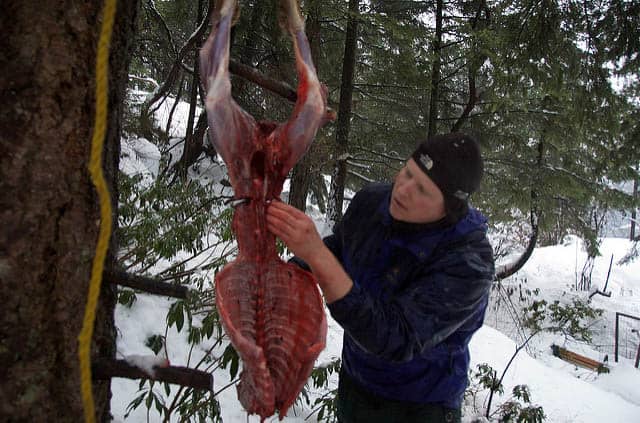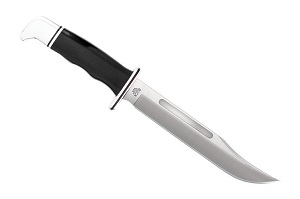Buck is one of the most well-known and respected brands of hunting survival knives. They are best known for their folding lockback knives.
When it comes to the fixed blade, the Buck 120 General reigns supreme with hunters.
The Buck 120 General knife came out in the 1960s, and since it has developed an almost cult following amongst collectors.
A few variations of the knife are available – all made in the USA. Here’s my review of the Buck 120 and what you need to know to pick the right model.
Review of the Buck 120 Knife

Length
The Buck 120 General knife has a blade length of 7 ¾ inches. When you add the handle length, the total length is 12 inches. It seems more like a short sword than a hunting knife.
Twelve inches is way too long for everyday carry (EDC). But, if you are a serious hunter, don’t be put off by the long blade. It really comes in handy — especially if you are after large game. It takes the hassle out of deboning.
I like that the handle is long. Most knife handles are too short and can cause your hands to cramp up after extended use.
It’s worth noting that the Buck 120 knife was popular with bikers. I guess they liked having a long, sexy knife. The length also made it ideal for fighting/stabbing (not that I’d recommend it for this purpose!).
Weight and Balance
For such a long hunting knife, the Buck 120 weight is still low (8.3oz). You can slice through game quickly and easily without feeling like the knife is weighing you down.
The extra length on the handle helps balance out the knife. I wouldn’t recommend this knife for most campsite tasks. However, it is comfortable enough for more than just skinning and deboning.
Blade
The Buck 120 has a clip-point blade with a very prominent sharp point.
I generally prefer drop point blades because they are more robust and can thus have more survival uses. However, there are times when you’ll appreciate a good clip-point blade, like when you want to cut a new hole in your belt.
Depending on your model, the blade material is either 420HC steel or 5160 steel (more on this below). Both of these are very strong and hold an edge well. You can skin an entire buck without having to stop to resharpen.
Style
It isn’t all just looks, though. The Buck 120 has a comfortable grip, and the finger guard prevents cuts.
Differences between Models
Blade Material Options: 420HC vs. 5160
420HC Steel
Not to be confused with ordinary 420 steel, 420HC is a stainless steel with added carbon (HC = high carbon). The extra carbon makes the blade harder.
420HC also has a high chromium and vanadium amount compared to the 5160.
The chromium helps protect against corrosion and adds some strength. However, it decreases the toughness of the blade.
5160 Steel
Usually, you won’t see 5160 steel on a hunting knife. It is typically found on swords and daggers. It has a low carbon amount compared to other carbon blades.
Even though 5160 steel is slightly less hard than 420HC (Rockwell hardness 57-58 vs. 58), it better resists breaking – especially during chopping actions. You’ll also find that it holds its edge longer.
The downside of any non-stainless blade is that it will require a lot more maintenance.
If you use or store the knife in a damp environment, I’d go with the 420HC. But if you use the knife for chopping, I would go with the 5160.
The Bottom Line?
- Choose 420HC if corrosion resistance is most important.
- Choose 5160 steel if toughness and durability are the most important.
Handle Options
The classic Buck 120 knife comes in a silver or black Phenolic handle. This is the cheapest option and is comfortable for most work. If you use your knife for extended periods, paying more for a wooden handle might be worth it.
Not only does wood look better, but it causes less slippage. The Buck 120 knives with wood handles also have sexy brass finger guards that look amazing.
Blood Groove
Some of the Buck 120 knives have blood grooves. The purpose of these grooves is to reduce the suction that occurs when thrusting a blade into a body.
Truthfully, I don’t feel any difference between the Buck 120s with and without blood grooves. If you can thrust your way into an animal, you can pull out just as easily.
Science backs this up too: the supposed suction never actually occurs. Basically, the blood groove is there to look sexy.
Best Buck 120 Knives Reviewed
Buck 120 General
This is the classic model of the Buck 120 and also the lowest-priced.
You can’t go wrong with this as a hunting knife. Pretty much everyone who’s bought this Buck 120 has nothing but positive reviews.
Features
- 420HC steel
- Blood groove
- Aluminum pommel
- Basic leather sheath
Buck 120 General 5160 BOS
Editors note: This knife is discontinued.
There are two things to pay attention to with this model of the Buck 120.
First, it has a dymondwood handle, adding style to the knife.
Secondly, this Buck 120 has 5160 steel. It’s a good choice for people who need toughness for campsite tasks but are also diligent about drying their knife before putting it away.
Features
- 5160 steel
- Blood groove
- Dymondwood
- Basic black leather sheath
Buck 120 Sheaths
The Buck 120 knife comes with a leather sheath. Usually, you are going to get the black leather sheath. Some models come with a slightly different sheath. The Buck sheaths are excellent quality and will hold up well.
Replacement sheaths are readily available on Amazon.
10 Oz. Water Buffalo Leather Sheath
Check out this sheath if you want something different and don’t mind paying for custom work.
Made by a USA-based artisan named Carl J. Thomas, Jr.
The pictures should speak for themselves – this is a beautiful sheath with expert stitching. Two things worth noting:
- The sheath is HORIZONTAL. Great for wearing along the back of your belt, especially if you find that the Buck 120’s length gets in your way when worn vertically. (Read more about the best horizontal carry knives.)
- Left or right handed. My wife is left-handed, so I know how difficult it is to find knife sheaths for lefties.
More pictures and prices on Amazon.






Dear Mr. Hunter, Obviously you are not aware of this, but there is no “blood Grove” on any of these knives. The indention on the side of the blade is called a “fuller” and derives its name from the tool the bladesmith uses to create it. It is there to lighten the blade. The “blood grove” is just a myth. I wasn’t aware of this either until I read an article by Mr. Bill Bagwell explaining it. You were right on the money with you review of buck knives. Best thing about them is where they are made. I had one when I was much younger. It was my first fixed blade knife. I passed it off to someone in S.E. Asia before I came home. Hope some one still loves it.
Hello I have some older Buck knives. Can I figure out which steel they have? There is no stamp which steel they have on them.
Can i purchase a sheath for the buck knife i lost mine
Yes they are available on Amazon – here